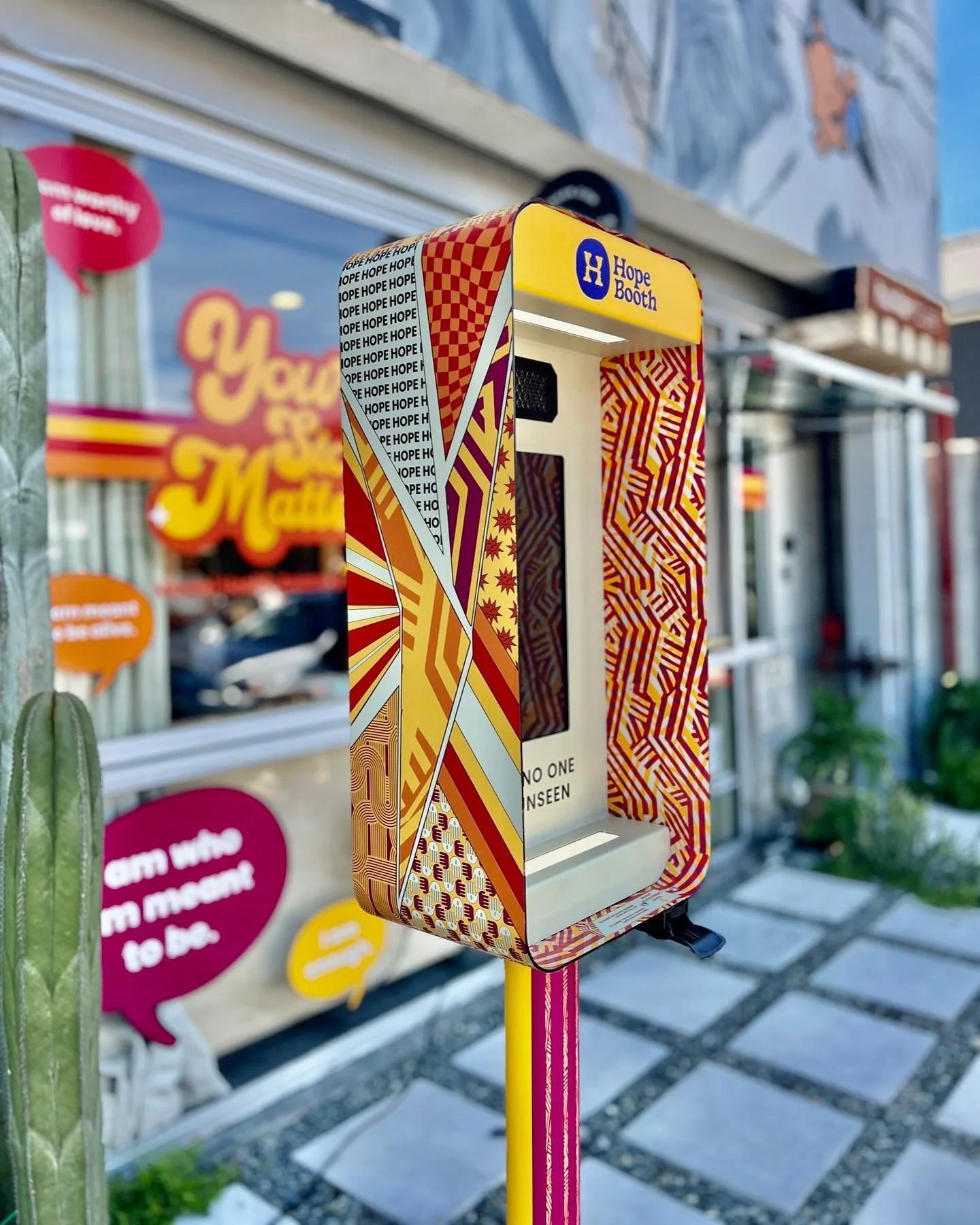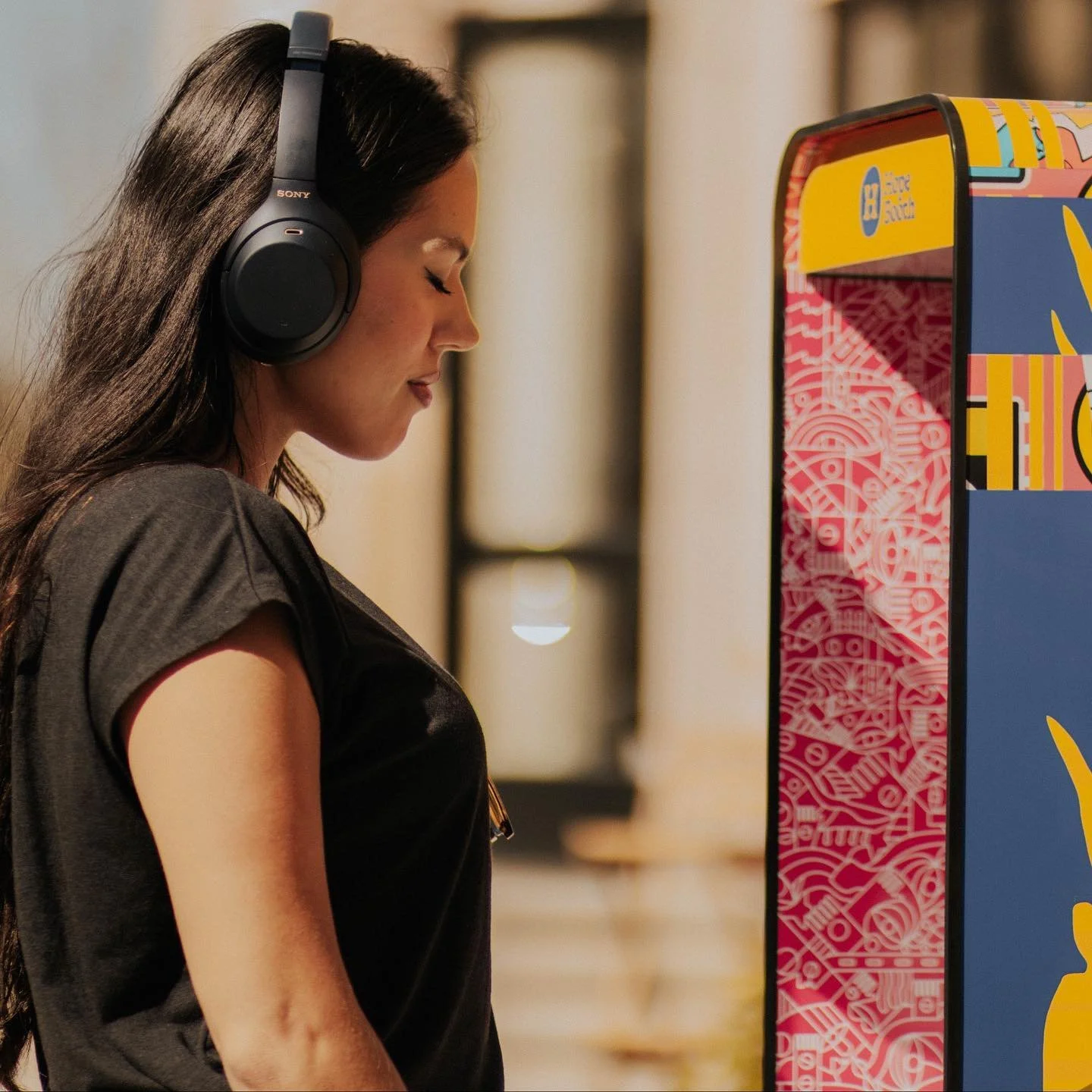Mental Health and Phone Booths with Gloria Umanah
Trigger warning: This article discusses heavy topics related to depression and suicidal ideation. If you or someone you know needs help, call or text the National Suicide and Crisis Lifeline at 988 (US).
Our generation is facing one of the worst mental health crises in existence. According to the International Association for Suicide Prevention, more than 700, 000 people lose their lives to suicide each year. The CDC has reported that over 48,000 people lost their lives to suicide in 2021, amounting to one death every 11 minutes across the United States.
Although already alarming, these numbers still don’t account for suicide attempts. For every person who dies by suicide, 20 or more may attempt to end their lives. In 2021, 1.7 million suicide attempts were reported in the US alone. These numbers bring to light the need for hope and mental healthcare in our society.
Gloria Umanah, an Atlanta-based spoken word artist, is bringing back this much-needed hope one phone booth at a time. She is the founding executive director of The Ex-Nihilo Collective and the visionary behind Hope Booth. Through Hope Booth, Gloria and her team seek to make mental healthcare accessible to people of all backgrounds.
Gloria’s mental health advocacy comes out of her own story of triumph over suicide and anxiety. She recently spoke to Jennie about her compassion for people struggling with suicide ideation. This is the edited interview:
Jennie: Tell us a bit about the journey that has led you to where you are today.
Gloria: At the height of the pandemic in 2020, our collective was unable to do our usual ministry around the world because all events were cancelled. During that time, I heard God so clearly say that our ministry needed to pivot from the stage to the streets.
And so, we looked at opportunities to use our creativity to impact people who may never go to church and those who maybe don't even have access to online churches. We wanted to find creative ways to bring hope to those people. I learned that the average person living on the streets goes three to six months without being looked in the eye. I was very troubled with the fact that we talk about El ROI, the God who sees. And yet, that somehow is a statistic.
I thought about the reality that the feeling of invisibility is not limited to someone's circumstance. In 2011, I almost lost my life to suicide because I felt invisible. I had a challenging upbringing that eventually led to an insurmountable amount of anxiety. I then went through a whole season of bullying, which led to a downward spiral of suicidal thoughts. I nearly lost my life on October 29, 2011.
What God is doing through the Hope Booth is, in essence, redeeming my story before my eyes. When we were figuring out what it looks like to pioneer a movement where no one goes unseen in 2020, we knew that meant creating something that would make hope and help accessible to everyone.
Jennie: The stats on suicide and suicide attempts are beyond alarming, and I can’t imagine what the numbers are when you add suicidal ideation as well. Let's talk about the unique way in which you are fighting this crisis.
Gloria: Trying to get a grasp of the numbers is very difficult. I get emotional when I think about the number of people who lose their lives to suicide every day because it could have been me. I wouldn't be here today if it weren't for hope. I'm troubled with the fact that most people are unbothered by these numbers until someone they know is affected. And if we wait for that moment, we've already waited too long.
If we carry the heartbeat of the Father, we have to care about the wellbeing of every person we walk by. That's why our movement motto is: “pioneering a movement where no one goes unseen.” The person walking down the street could be having a horrible day and internally praying that God sends someone to just smile at them.
If we can each carry the weight of spreading hope everywhere we go, these numbers will drastically drop. We've spent years doing research, and these numbers are only increasing. That's the problem with mental health awareness. We are very aware of the current state of things, but there’s not enough action.
Our organization's heartbeat is that we will move from just talking about stats to figuring out ways to decrease those stats.
Jennie: What do you want to see happen with this idea?
Gloria: I want hope to be accessible to everyone. The phone booth makes hope accessible to someone who might not have internet access or even a portable device that allows them to search for resources. Growing up, we would drive around Atlanta at night, and it was very easy to find these phone booths because of the light they emitted. That is a pure depiction of what hope is – light in the midst of darkness.
These phone booths are easily accessible to the older generations who might not have access to cellphones or might not prefer them at all. At the same time, it’s a reminder to the new generations to limit their time online. We’re helping them get off the phone and take a moment to pause and be mindful.
There are many different elements in the Phone Booth experience that give people the opportunity to put their phone down. The excessive time we spend on our phones is often the reason for the anxiety and chaos we feel. And so, we wanted to create something where people didn’t need to be on their phone, iPad, or computer.
People can stumble upon one of these phone booths in a local hospital, library, street corner, school, or another public setting and be able to experience hope. They can then connect to local help and support if needed.
Jennie: Let's talk about what it is you walk up to on these phone booths. What does it look like?
Gloria: It looks like a regular phone booth, but it is very artistically beautiful. So, it naturally catches your eye. On our base, we have signage that reads: “Need hope? Stand here.”
The Hope Booth has some recognition elements, so it knows that someone is standing there. You then click to begin the experience. The very first element is a hope meter, which is ultimately an internal scale where you can select how you're feeling. We use the hope meter to dictate which experience someone will get.
The second step is safety measures for us to get the right experience for someone. Most people don't know how they're feeling. So, we don't totally rely on the hope meter. We have a second segment where a user has about 30 seconds to select emotive words that we will then use to determine how that person actually is feeling. This is to help release the pressure off people when they don't know how they're feeling and help give them verbiage.
The metrics of these two segments help us determine which of the 19 experiences a person will get. We wrote these experiences with a group of psychologists and therapists to determine the level of accuracy each individual would need based on the results they get from the two segments.
Someone who might be struggling with suicidal ideation would get a very different experience than someone who maybe just needs a bit of encouragement for the day. Both groups of people need hope but in very different ways. And so, we created very different experiences for each type of person.
The phone booth has a 92-second message of hope that we wrote with really incredible psychologists. It's got a measure of breathwork as well. It's so simple, but we often forget the power of breathing. So, there’s an entire segment dedicated to breath work.
There’s a mixture of animation, composition, scoring, and some sound elements to make it immersive. It's got a mixture of some declarations and affirmations that we believe are helpful for people in their journey towards hope.
My favorite aspect is the very final element – a five-mile radius support system. We believe the greatest way to give people the hope they need is to connect them to the help they need. That can be a therapist, a church, a food bank, employment, or a homeless shelter nearby, among other resources.
Jennie: Do the churches know that you're putting them in there? Talk about the church support and the relationship you have with surrounding churches.
Gloria: With every element of the support system, our goal is to ensure that we believe in the work these individuals and organizations are doing. We want to connect people to individuals and organizations that can really help them and not lead them further down a path of hopelessness.
The churches, therapists, and shelters we work with are all part of our network. In all these different cities and communities around the globe, we’re constantly adding to a mass network of support that we can connect people to.
There have been churches and organizations doing the work long before I was born. And so, we don't want to appear as superheroes in these cities. We want to show up as a catalyst for those who are doing the work.
Our desire is to connect people to them and support them by lifting their arms when their strength has grown weary. And this is the simplest way we can do that.
We can also see this data and advise churches on how they need to pray for their cities. So, we can pray more accurate prayers because we have some data to prove how low the hope meter is. That's our goal with that support system aspect.
Jennie: You've trialed some of this, and you're about to launch the live Hope Booths everywhere this month. What have you learned from the pilot phone booths you’ve released?
Gloria: We did the Hope Booth debut with our first prototype in October 2021 in London. Although we're all American in our team, we knew that this is going to be a global movement. So, we debuted the booth in another country that's seemingly not as friendly or overly outgoing.
Their response was amazing. We initially set the phone booth on the street because we were filming a promo video, but the entire city stood still. Cars stopped at green lights to see what was going on. Construction workers came over too. Many people started taking photos and asking questions.
We hadn’t planned for people to experience it then, but it happened. It was amazing because it basically met the need of people before they were even able to vocalize it. People who didn’t realize they needed hope would come out in tears after two minutes in the booth.
Many people who experienced the Hope Booth needed hope just for the day. But then there's a whole tier of people who needed hope to live another day. So many people approached us to say they don't know if they would have made it to the following day if they didn't experience those three minutes in the Hope Booth.
I never would have imagined that this would be the outcome. But that's how I know we are doing exactly what we're supposed to be doing.
Jennie: This is so well done, and I am beyond proud of you. So, how do we help? How do we partner with you?
Gloria: Our goal this year is to get 100 Hope Booths sponsored and installed around the globe. Our first one is already set to be in Scotland. This is made possible by very regular people who come together with other regular people to be the catalyst for hope in their community. So, they sponsor a booth in their city, school, or hospital.
We often count ourselves out immediately when we see big projects like this, but there is a way. Being an advocate for the work we're doing can sometimes look like fundraising with your community to sponsor a booth. It could be getting your local church to sponsor a booth through their outreach initiatives. When sponsored by a church, we can have a plaque that says sponsored by “XYZ” church on the Hope Booth.
It’s so important for our churches to come alongside us so that when people see these Hope booths in their city, they know that the church is for them even before they walk through those doors. That's how you get people into the doors.
Ultimately, we want Hope Booth to be built for the community by the community.
Jennie: As we close, I want you to speak to someone who needs hope right now. Could you speak to that person who needs to make it another day?
Gloria: If you feel very low on hope and you're not sure that you can even make it another day, I want to encourage you to look at your track record. This is not the first time you have felt this way, and you have made it every single time. And because you have made it before, you can make it again.
You just have to keep saying “yes” every day. Say “yes” to choosing to live even when it's difficult. I know that this is a story that ends in hope for you. Even if it doesn't feel or look like it at the moment, brighter days are ahead. And you only get to see them if you keep saying “yes.”
Sometimes we think our struggles define us and have the power to take us out. But you existed long before you ever had a struggle, which means your struggle isn't powerful enough to define you. It's not powerful enough to be the banner over your life. Hope will win in your story. Please stay.
Help is available. If you need hope and help right now, Text HOPE to 741741 for free confidential support from a trained counselor. You can also call or text the National Suicide and Crisis Lifeline at 988 if you are in the United States. There are several ways you can give to Gloria and her team’s cause. You can visit the Hope Booth website to become a founding partner, give a one-time donation, give at a reoccurring level, or sponsor a booth.




